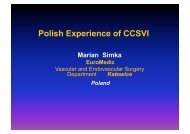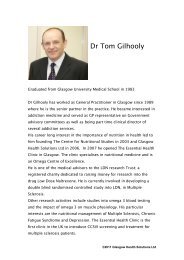ISNVD Abstract Book
ISNVD Abstract Book
ISNVD Abstract Book
You also want an ePaper? Increase the reach of your titles
YUMPU automatically turns print PDFs into web optimized ePapers that Google loves.
EVALUATION OF MUSCLE METABOLISM IN MULTIPLE SCLEROSIS:<br />
A NEAR INFRARED SPECTROSCOPY-BASED APPROACH<br />
Anna Maria Malagoni, MD, PhD, Michele Felisatti, PhD, Nicola Lamberti, BS,<br />
Paolo Zamboni, MD, Fabio Manfredini, MD<br />
Vascular Diseases Center, University of Ferrara, Italy<br />
2nd Annual <strong>ISNVD</strong> Scientific Meeting<br />
18-22 February 2012 (Orlando, Florida USA)<br />
PURPOSE<br />
•To determine muscle metabolism of gastrocnemius in a static phase<br />
(oxygen consumption) and in a dynamic phase (oxygen changes during an<br />
incremental treadmill test) in multiple sclerosis (MS) patients compared to<br />
healthy subjects, and<br />
RESULTS<br />
rmVO 2<br />
was significantly higher in all MS legs compared to healthy legs (P=0.01)<br />
(Fig.1),<br />
•To compare in MS patients the results of the dynamic test with the validated<br />
6-minute walking test (6MWT).<br />
INTRODUCTION<br />
Near Infrared Spectroscopy (NIRS) allows a non invasive study of muscle metabolism<br />
under static and dynamic conditions. NIRS based methods have been applied for<br />
healthy and diseased people [1-4], but poorly in studies with MS patients.<br />
Fig.1.Comparison of resting muscle oxygen<br />
consumption between Healthy and MS<br />
subjects<br />
also analyzing separately PP and RR clinical types (P=0.004) (Fig.2).<br />
MATERIALS AND METHODS<br />
SUBJECTS<br />
MULTIPLE SCLEROSIS (n=28)<br />
HEALTHY (n=11)<br />
Legs (n) 56 22<br />
Sex (n) M=16; F=12 M=6; F=5<br />
Age (years) 42.7±14.0 33.2±8.9<br />
Clinical Types Relapsing Remitting (RR): N=19 -<br />
Primary Progressive (PP): N=9<br />
Disease duration (years) 9.9±6.3 -<br />
EDSS 3.8±2.2 -<br />
Fig.2.Comparison of resting muscle oxygen<br />
consumption among Healthy and MS<br />
clinical types<br />
O 2<br />
Hb AUC<br />
, HHb AUC<br />
, dHb AUC<br />
, and tHb AUC<br />
did not<br />
differ between all MS and healthy legs but<br />
different patterns of O 2<br />
Hb AUC<br />
related to PP<br />
legs were highlighted with lower values<br />
than healthy and RR legs (P=0.02) (Fig.3).<br />
Fig.3.Comparison of oxygenated hemoglobin<br />
(area under curve values) among Healthy<br />
and MS clinical types<br />
1) NIRS evaluation<br />
a) Static measurement<br />
Oxygen consumption (rmVO 2<br />
) at gastrocnemius muscle<br />
was measured at rest by venous occlusion [5].<br />
b) Dynamic measurement<br />
All healthy subjects and all<br />
ambulatory MS patients (n=27)<br />
performed an incremental level<br />
treadmill test with NIRS probes on<br />
the gastrocnemius muscle.<br />
Protocol: starting speed set at 1.0<br />
Km/h, increases of 0.1 Km/h every<br />
10 m to exhaustion (maximal speed)<br />
[4].<br />
c) Data processing<br />
Variations in oxygenated (HbO 2<br />
),<br />
deoxygenated (HHb), total (tHb=<br />
HbO 2<br />
plus HHb), and differential<br />
(dHb=HbO 2<br />
minus HHb) hemoglobin<br />
were recorded and quantified as<br />
area-under-curve (AUC) within the<br />
speed range 1.0-2.0 Km/h [4].<br />
Cardiovascular load<br />
Heart rate was recorded during the<br />
treadmill test, and the variation of<br />
beats within the speed range 1.0-<br />
2.0 Km/h was calculated (dHR).<br />
2) Six Minutes Walking Test<br />
a) Incremental treadmill test; b) NIRS<br />
semiquantitative data; c) Transformation into<br />
quantitative data by area-under-curve calculation<br />
In MS ambulatory patients, indoor 6MWT was also<br />
performed and the distance covered was assessed<br />
(6MWD).<br />
A significantly higher dHR<br />
was observed in all MS<br />
patients (P=0.0003) (Fig.5)<br />
compared to healthy<br />
subjects, also according to<br />
both MS clinical types<br />
(P




